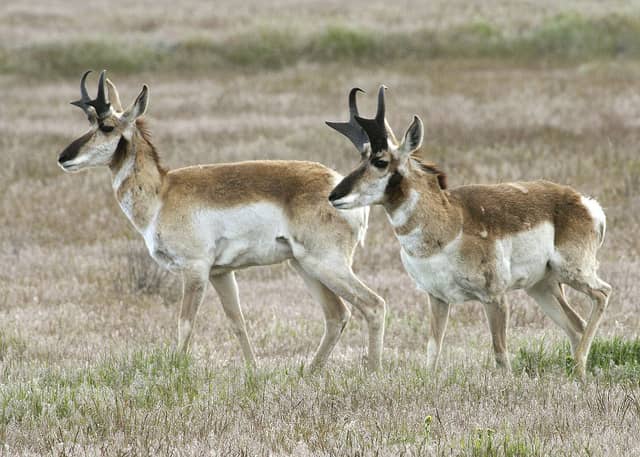Pronghorn Field Care
Anne Vinnola 08.20.12

When we think of pronghorn, most of us refer to them as antelope, but they are not really from the antelope family at all. Pronghorns are a unique, North American species all their own with five subspecies.
The main identifying characteristic separating the American pronghorn from other big game animals is their horns. The pronghorn is not an antlered animal such as an elk or deer. It is a horned animal more like cattle. Pronghorns have a branched sheath made out of fused hair, or keratin, which covers a bony core but unlike cattle, pronghorns shed their horns annually.
Both males and females grow horns but the horns on females are much shorter than the males, with only a slight prong. Males have black patches on their cheeks close to their neck and females generally do not.
Pronghorns are the fastest animals in the Western Hemisphere, reaching speeds of up to 70 MPH. Pronghorns rely on speed and sharp eyesight for protection and can spot danger as far as 4 miles away.
Occasionally you will find a pronghorn with rub marks or broken hair along their back. This is because pronghorns avoid jumping fences, preferring to go under them.
I am including a few suggestions to pronghorn hunters so they can see their trophies get to their taxidermist in the best possible condition for mounting.
To prevent some of the hair problems pronghorns are notorious for care needs to be taken in the field.
When a pronghorn has been killed the hair follicles can become stained on the inside with blood, much like a straw and be extremely hard to remove. These hollow hair follicles are also very brittle and easily damaged.
After you have killed the pronghorn, NEVER slit the throat. This cuts the hair and encourages blood to soak into the cape thus ruining it. This is a no-no for any other big game animal you want mounted as well.
Avoid dragging the animal even a short distance. Roll it on to a tarp to drag it if you must, or better yet, gut it and carry it out. Try not to pull or tug on the hair while moving your pronghorn.
“Hair slip” is a huge problem with pronghorns especially when they are harvested in the early warmer seasons. “Hair slip” is where the hair begins to shed from the cape. It is directly related to temperature and bacteria growth as much as trauma.
Your pronghorn needs to be cooled immediately after you kill it. Bacteria starts to grow at 40 degrees and you will most likely be hunting in warmer weather. Take a 5 gallon jug of water with you to help cool and rinse the cape after you have removed it from the carcass. If you have to wait a day or two to see your taxidermist, pack the head and cape in ice. A great way to cool the rest of your animal is to take a block of ice in a cooler with you for each tag you are filling, then when you have gutted the animal shove the block up into the cavity.
Most taxidermists prefer to finish “caping” the face but want to have the head removed from the body if you are having a shoulder mount done. To do this, you need to begin your cut at the back of the head about 1 inch down from the bump. Proceed along the back of the neck to 4-6 inches behind the front legs and circle the body. Detach all of the skin from the body leaving 4-5 inches of neck, rinse and cool the cape.
If you are having a full body mount done, then take the whole thing to your taxidermist immediately for help caping it.
With good field preparation pronghorns make gorgeous mounts but continued care needs to be taken to insure that your mount lasts a long time in your home. Do not hang it in an area where it will be exposed to direct sunlight or high temperatures such as over a fireplace. Pronghorn mounts are best placed in a room where the temperature and sunlight are regulated. In order to clean them, dust them with a slightly damp rag, or a feather type duster. Be careful not to grind dirt into the hairs as you clean them.
Pronghorns are beautiful, unique and tricky to shoot. Having a nice one on your wall is truly a measure of skillful hunting, careful field care and great taxidermy.

